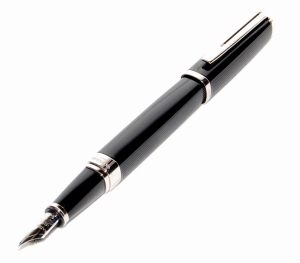Exceptional Exception
August 25, 2010 § Leave a comment
The Waterman Exception fountain pen is a shining example of radical and yet stylish design. Its deep-lacquered, rounded-off, square sectioned barrel gently transforms into a more conventional round section towards the front end grip. The Exception is quite a statement piece. It is surprisingly comfortable to hold, given the unusual profile. The Exception comes in 2 model sizes, the standard or slim version which is extremely elegant without being over-large. The Night and Day, and Ideal models are significantly larger and, in my opinion, the design loses some of its elegance when scaled up.
The nib is an 18ct unit of visually balanced size, finished in gold or with rhodium plating to match the trim of the pen. The nibs are available in a range of sizes and styles including, stub, oblique fine, and oblique broad, but the catch that Waterman have taken a while to concede is that, any change of nib, either by choice or to restore an injured number, require the pen to be returned to the factory for fitting and alignment. This has proved a bit of a drawback for users and retailers alike. If you’re looking for something that’s a bit different, please do not dismiss the Exception but be aware of its little idiosyncrasy.
What is your pen made from?
July 27, 2010 § Leave a comment
Fountain pens are manufactured using a wide range of materials the sum of which contribute to the design, performance and perception of the finished pen. While many of the materials are relatively common, the reason for their use in pen construction may not be as obvious. We will expand the information in this section over time to include some of the fascinating and more historical products used in pen construction. These descriptions are covered on the PenFountain.com website
Barrels and Caps
Resin: A generic term used in fountain pens to cover a wide range of plastics. Many ‘resins’ are pigmented acrylic resins used either as a single colour or mixed in multiple colours without becoming homogeneous to create swirls and coloured effects.
ABS (acrylonitrile butadiene styrene) is a sophisticated plastic compound used principally in Lamy pens but used extensively in industrial applications in automotive, furniture, electronics and toys including Lego bricks. ABS is used for its dimensional stability, durability, and resistance to UV degradation making it suitable for highly coloured products. Hence the brightly coloured pens found in the Lamy Safari range!
Brass: An early form of an alloy of elemental metals, brass is a combination of copper and zinc. Alloyed in different proportions, brass can offer strength, malleability, corrosion resistance, and, in finished component form, has almost no requirement for lubricant for faces in close contact such as screw threads. Brass is used extensively as a core metal for the production of quality fountain pen barrels and caps with its compatibility with metallic plating processes and coloured lacquers.
Fittings and Nibs
Gold: A dense, soft, malleable, elemental metal which, with its mechanical properties and resistance to oxidisation, is an ideal material for the production of fountain pen components.
Silver: A soft white lustrous elemental metal. Sterling standard silver is 92.5% pure, the balance usually being of copper.
Steel: Many fountain pen nibs and components are manufactured from either chrome plated steel or stainless steel. Whilst traditional opinion is that the best nibs are only produced from gold because of its softness and spring, a good quality steel nib, in many cases, will serve its user equally well. With many nibs, gold or steel, the pen is often not even used often enough to make any significant difference to its tip profile. The issue is more about the design and finishing of the nib because, unlike gold, a steel nib is unlikely to wear into the style of the users hand. In which case, the design and finishing is more critical than the material it is made from. Examples of particularly good steel nibs are those used in the Caran d’Ache Ecridor range and the stainless steel nibs from Lamy with their wide range and simple inter-changeability. Electro-plated steel is also used in the construction of most pens’ clips because of its spring.
Platinum group: Rhodium, palladium and iridium are chemically inert mineral elements which are part of the platinum group and are similarly rare. They are used industrially either alloyed with other platinum group metals or used as catalysts in chemical processes.
Rhodium plating is used extensively in fountain pen nibs as decoration, often over a gold nib where the mechanical characteristics of the gold are desirable but a silver trim finish is required. The limited depth of the rhodium will have no effect on the characteristics of the nib. Rhodium is also used as a fine plated coating over silver plating, such as on the Waterman Carene Essential Wave silver pens, to protect the finish from discolouration, wear and corrosion.
Palladium is used occasionally in pens in a similar manner to rhodium, more usually in the manufacture of trim components.
Iridium, a relatively dense element, can also be used in the manufacture of nibs to offer a more durable writing tip.
